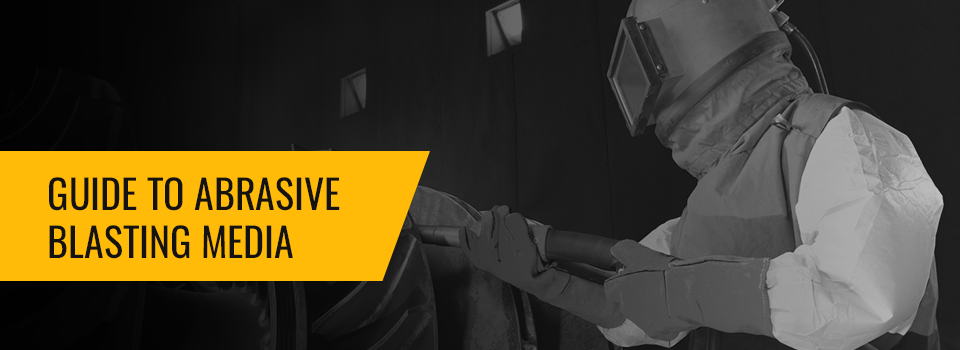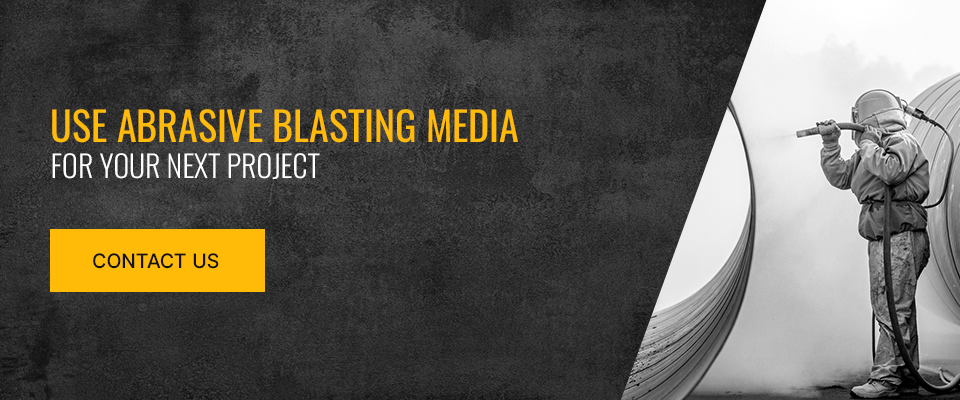Guide to Abrasive Blasting Media

While the common term may be “sandblasting media” or “sand blast media,” many different types of media blasting have replaced sand as the abrasive of choice when it comes to finishing, shaping or otherwise modifying a surface. Abrasive blasting can involve softer materials, like walnut shells and baking soda, or harder materials, like silicon carbide and steel-shot hard media, that cut through incredibly tough surfaces. Whatever material is used, abrasive blasting can strip paint, remove mold and fungus, add surface finishes, prepare material for painting or coating and even improve the characteristics of the surface, like fatigue resistance.
If you need to do some abrasive media blasting, but don’t know what type of blasting media you should use, this guide to abrasive blasting media walks you through six of the more common types.

1. Glass Bead Blasting
What Is Glass Bead Blasting?
Glass bead blasting is a versatile approach to abrasive media blasting that offers an attractive satin finish and works for a variety of purposes. It uses lead-free soda lime-type glass in rounded ball shapes. Part of glass bead blasting’s appeal lies in the smooth, bright finish it creates that differs from the matte look of more angular abrasives.
What Are the Advantages of Glass Bead Blasting?
Glass bead media has many advantages over other types of abrasive blasting media. Aside from the attractive finish, blasting with glass beads features other benefits, including:
- No free silica
- Environmentally friendly
- Recyclable
- Good for delicate, thin-walled parts
- Chemically inert
What Are the Disadvantages of Glass Bead Blasting?
If you have a particularly tough material, glass beads may take a little longer to get the job done. They also will not provide any etch to the surface.
What Is Glass Bead Blasting Used For?
Glass beads can help you achieve a uniform surface finish without changing the dimensions of a part. They are not as aggressive as some other mediums and are good for metals like stainless steel.
Some of the uses for glass bead blasting include:
- Peening
- Deburring
- Removing rust, paint and scale
- Cosmetic finishing
- Removing calcium deposits
- Polishing materials like cast iron, stainless steel and aluminum
- Preparing metal surfaces for painting and powder-coating
One unique application for glass bead blasting is peening, which helps the metal better resist fatigue and cracking from stress corrosion. One study found that it can increase fatigue strength by about 17.14%. It gives you an attractive satin finish while increasing the durability of the product.
2. Sand Blasting
What Is Sand Blasting?
Using traditional sand is how abrasive blasting got coined as sandblasting media, but it has actually fallen out of favor in recent years due to one major reason: silica. Sand includes silica, which forms dust when the sand erodes and poses a significant health hazard to those working with it. Silicosis is a deadly condition that affects people who breathe in these chemicals. Many countries have banned silica entirely, and the Occupational Safety and Health Administration (OSHA) has set limits on its usage. The measures you need to take for sandblasting media and using silica safely are extensive, so it is often much easier and more beneficial to use another blasting media that fits your application.
What Are the Advantages of Sand Blasting?
Most of the benefits of using silica sand for sandblasting media can be met with the use of other materials. Part of its previous use is due to its sharp edge and uniform size.
What Are the Disadvantages of Sand Blasting?
Aside from the health risks, using silica sand for sandblasting media has other downsides:
- Using sand requires a significant amount of raw material, which makes it cost-prohibitive for many applications.
- Silica sand holds moisture, which can transfer onto the equipment and cause it to wear out faster.
What is Sand Blasting Used For?
In the past, silica sand was one of the most common abrasives used. Sandblasting media was versatile and worked well on an array of structures like bridges and ships.
If silica must be used today, it is often performed in an isolated blast room with extensive personal protective equipment (PPE).
3. Aluminum Oxide Blasting

What is Aluminum Oxide Blasting?
Aluminum oxide blast media is one of the more aggressive blasting materials that can offer fast results and superior strength. Its angular but lightweight design allows it to create deep etching without adding surface stress to thinner substances.
What Are the Advantages of Aluminum Oxide Blasting?
Aluminum oxide is good for many applications, with benefits including:
- Hard and strong enough for tough metals
- Fast etching and profiling
- Lightweight, so it will not damage thinner materials
- Cost-effective
- Recyclable
What Are the Disadvantages of Aluminum Oxide Blasting?
Some difficulties with this material do occur, and aluminum oxide:
- May be too aggressive for some surfaces
- Can be harsh on abrasive blasting equipment
What is Aluminum Oxide Blasting Used For?
With its sharp edges and hardness, aluminum oxide is often used in:
- Grinding
- Polishing
- Edge rounding
- Paint removal
- Finishing
- Preparing surfaces for painting
It can be used with glass, marble, granite, steel and more.
4. Plastic Abrasive Blasting
What Is Plastic Abrasive Blasting?
This dry cleaning media is versatile and popular for several reasons. It is a rather soft media that is great for applications where only surface-level removal or modifications are needed. It can help to remove unwanted materials without harming the substrate underneath. Many industries benefit significantly from this type of abrasion, as it offers effective cleaning without destroying the item.
The abrasives are made from crushed urea, polyester or acrylic plastic. Hardness and particle size can vary, but they are angular pieces.
What Are the Advantages of Plastic Abrasive Blasting?
Some advantages of plastic abrasives include:
- Surface-level abrasion that does not damage the underlying material
- Low dust levels
- Available in a versatile selection of sizes and shapes
- Durable
- Free of silica
What Are the Disadvantages of Plastic Abrasive Blasting?
While they are useful for cleaning tasks, plastic abrasives will not work well on hard metals or for finishing applications. They may work more slowly on softer materials.
What Is Plastic Abrasive Blasting Used For?
Plastic abrasives are common in delicate applications or cleaning. You may find them used for paint stripping, mold removal, deburring and deflashing. They are useful in stripping paint because of their safety advantage over chemical stripping and their general effectiveness. The materials that are often used with plastic abrasives include:
- Aluminum
- Brass
- Fiberglass parts
- Plastics
Industries such as automotive, aerospace, marine and electronics use plastic as a blasting media. Often, these industries create sensitive components that cannot have their substrate material modified. Plastics make this possible.
5. Walnut Shell Blasting
What Is Walnut Shell Blasting?
Walnut shell abrasive media is a biodegradable, low-cost coating removal technology that offers a gentler alternative to traditional abrasive blasting media.
Crushed black or English walnut shells are lightweight and angular and can effectively remove top coats without damaging underlying coatings. Before the introduction of this abrasive media, metal finishers typically had to strip workpieces down to the bare metal and replace all coatings in the final process.
What Are the Advantages of Walnut Shell Abrasive Blasting?
Walnut shell abrasive media offers numerous advantages:
- Nontoxic
- Generates minimal dust
- All-natural and biodegradable
- Reusable
- Cost-effective alternative for removing top coats of paint while preserving the base, primer and gel coats
- Reduces cycle time in finishing applications such as air and wheel blasting and tumbling operations
What Are the Disadvantages of Walnut Shell Blasting?
Walnut shells fall short in some abrasive blasting applications. This media is:
- Less effective on extremely hard or thick coatings
- Unsuitable for heavy-duty applications
What Is Walnut Shell Blasting Used For?
Walnut shell blasting is invaluable in many applications, such as:
- Deburring and deflashing parts, thermosets, die castings and plastics
- Improving porosity in ceramics and grinding wheels in burnout applications
- Stripping and cleaning moldings and castings
- Removing paint and coatings from metallic surfaces on boats, ships, automobiles, buildings, statues and bridges without damaging underlying layers
- Clearing graffiti and mold from objects
- Cleaning out aircraft engines and steam turbines
6. Steel Shot Blasting
What Is Steel Shot Blasting?
Steel shot blasting is a surface preparation and cleaning process in which spherical steel pellets are propelled against a workpiece at high velocity to remove rust, paint, scale and other contaminants from surfaces.
What Are the Advantages of Steel Shot Blasting?
There are many advantages that come with using steel-shot blasting as the abrasive media of choice, including:
- Cost-effectiveness
- Reusability
- Versatility
- Recyclability
- Consistent results
What Are the Disadvantages of Steel Shot Blasting?
With steel being one of the harder media types, it comes with some cons as well:
- Hazardous dust that requires the proper use of protective equipment
- Noise pollution
- Unsuitable for delicate surfaces
- Heavy weight for size
- Risk of rebounds
What Is Steel Shot Blasting Used For?
Steel shot blasting is widely used across various industries, such as cleaning and finishing vehicle parts in automotive operations, preparing concrete surfaces for sealing or painting in construction, and cleaning and preparing metallic parts for further processing after metalworking operations.
Use Abrasive Blasting Media for Your Next Project
Projects across industries have unique needs, and the blasting media that you use on them can make a big difference. Be sure to weigh the pros and cons of each media to determine which one will work best with your material.
We find that many applications can benefit from glass bead blasting. Whether you need to finish a metal, add texture, remove paint or mold, or prepare a surface for coating, glass bead blasting is often an excellent option. Do not forget about the uniform, satin finish and the fatigue resistance that it offers.
Find the Ideal Abrasive Blasting Media for Your Project
If you need glass bead blasting, contact the experts at Hard Chrome Specialists. Our family-owned company provides friendly, honest services with quick response times. For more information about our process, and to learn how it can benefit your parts, contact us today.


